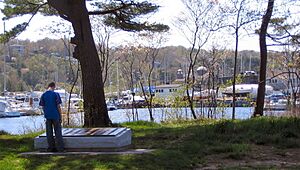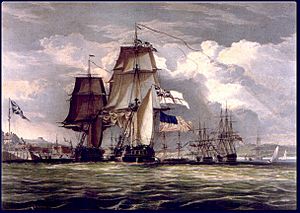Deadman's Island (Nova Scotia) facts for kids
Deadman's Island is a special place in Nova Scotia, Canada. It's not really an island, but a piece of land sticking out into Halifax Harbour. This area has a long history. It was once a training spot for the British military. Later, it became a burial ground for soldiers captured during wars. These prisoners were kept on nearby Melville Island.
In the early 1900s, Deadman's Island turned into a fun amusement park. Then, in the 1960s, it became part of the city of Halifax. People wanted to build new things there. But many residents protested these plans. Because of their efforts, Deadman's Island was saved. Today, it is a beautiful heritage park called Deadman's Island Park.
Contents
What is Deadman's Island?
Even though it's called an "island," Deadman's Island is actually a peninsula. This means it's connected to the mainland by a narrow strip of land. It reaches out about 200 meters (656 feet) into the Northwest Arm of Halifax Harbour. The land is a bit swampy in places, with a small hill covered in pine trees. The water on its eastern side is home to many fish. This area might also hold clues about people who lived there long ago.
A Place for Soldiers and Prisoners
This land was first known as "Target Island." The British Navy used it for target practice. During the Napoleonic Wars and the War of 1812, the British military used it for a different purpose. They buried prisoners of war here. These prisoners came from a jail on nearby Melville Island.
Many soldiers and sailors died while being held captive. Sixty-six French, nine Spanish, and 195 American soldiers were buried here. They were placed in canvas bags in unmarked graves. This is how the island got its name, Deadman's Island.
The island might also be the resting place for other people. After 1813, some escaped slaves came to Melville Island. At least 104 of them died. In 1847, Irish immigrants were quarantined on Melville Island. Thirty of them also died. These people may have been buried on Deadman's Island too.
After 1847, people stopped burying bodies on the island. Melville Island continued to be used as a prison. There was only one known marked grave on Deadman's Island. It belonged to a Canadian sailor named John Dixon. He was buried in 1847. A local story says Dixon fell in love with a British colonel's daughter. The colonel supposedly sent him to prison, where he died. However, this story is probably not true.
From Amusement Park to Heritage Site
In 1907, the British government sold Deadman's Island to a businessman named Charles Longley. He built an amusement park called Melville Park. It was a fun place for children who lived in cottages nearby. Longley even set up a ferry to bring people across the water to the park. The ferry ticket included free entry to the park every day.
The park offered many activities. There were swings, slides, and dancing on certain nights. People could also enjoy "water sports" on Saturdays. A large building was built for these activities. It had space for boats and a dance hall upstairs. During construction, three skulls were found. They were placed in the rafters of a room to playfully scare visitors.
Melville Park was popular at first. But then the First World War started. The Halifax Explosion in 1917 also caused problems. An economic downturn in the 1920s led to money troubles. The park eventually closed in 1927. In 1936, Longley gave John Dixon's grave marker to the Nova Scotia Provincial Museum.
In 1930, A.J. Davis bought Deadman's Island. He reopened it as a "pleasure park." The Ryan family took over most of the land in the late 1930s. Over time, storms and building projects started to uncover skeletons. In 1959, a local resident found a skull near his home. It was hard to find the exact burial spots because there were no grave markers left.
Protecting a Historic Place
In the late 1960s, Deadman's Island became part of the city of Halifax. There were plans to build tall apartment buildings there. But a local group, the Northwest Arm Community Planning Association, protested. They wanted the land to be a park instead. Even though their idea was not accepted right away, no new buildings were built on the island.
By the 1990s, Deadman's Island was one of the last undeveloped areas along the Northwest Arm. In 1998, new plans for condominium buildings were suggested. Again, community groups protested. The Northwest Arm Heritage Association started to research the prisoners buried there. Other groups from the Maritimes and New England joined them. They asked the city to recognize Deadman's Island as a heritage site.
This issue became known internationally. It was mentioned in newspapers like The Globe and Mail and The New York Times. The city hired a historian to study the site. His report said that as many as 400 bodies could be buried there. This was much more than what developers had first thought. The city also saw the site as a way to attract American tourists, similar to the memorials for victims of the Titanic disaster.
The plans for new buildings were stopped in late 1998. In February 2000, Deadman's Island Park was officially created. The Halifax Regional Municipality established it to protect the site and remember its history. A special service was held on June 23, 2000, for the American Prisoners of War buried there. Members of the U.S. 164th Civil Engineering Squadron were the first U.S. service members to honor those in unmarked graves.
On May 30, 2005, a large plaque was put up. It remembers the American servicemen buried in unmarked graves. An Honor Guard from the USS Constitution in Boston attended the plaque dedication.
Quick facts for kids Deadman's Island Park |
|
|---|---|
| Type | Public park |
| Location | Halifax, Nova Scotia |
| Created | 2005 |
| Operated by | Halifax Regional Municipality |
Deadman's Island Park is a public park in Halifax Regional Municipality, Nova Scotia. It is located on Deadman's Island in the Northwest Arm of Halifax Harbour.
The park was created in 2005 to protect the land from new buildings. It is the burial site for 195 American soldiers and sailors. They died while being held by the British during the War of 1812. They were prisoners at a jail on nearby Melville Island.
A special plaque in the park shares a poem:
-
- Go view the graves which prisoners fill
- Go count them on the rising hill
- No monumental marble shows
- Whose silent dust does there repose.
- Go view the graves which prisoners fill
More than 8,000 American prisoners were held on Melville Island over time. French and Spanish prisoners of war were also buried on Deadman's Island. Their graves are not marked. The details of these unmarked graves were forgotten for many years. But interest grew again when the owner of the land wanted to build homes there.
Many groups worked together to save the property. These included the Northwest Arm Heritage Association, the Ohio Society of the War of 1812, and the Royal Canadian Legion. Because of their efforts, the city bought the land.
On May 30, 2005, the U.S. government put up a memorial tablet. It lists the name, rank, and ship of each American man buried there. Some of these men served on the USS Chesapeake. This was one of the first six frigates of the United States Navy. The British captured it and brought it to Halifax.



